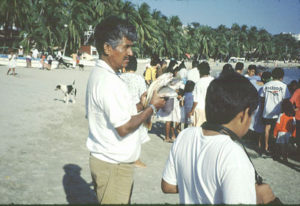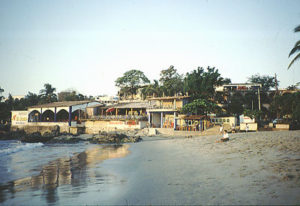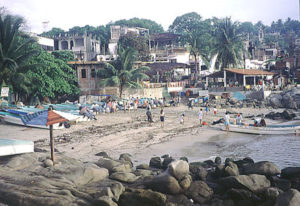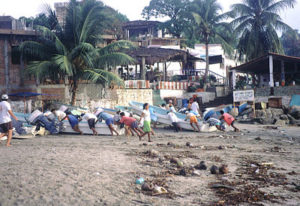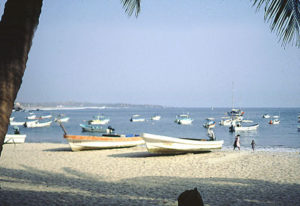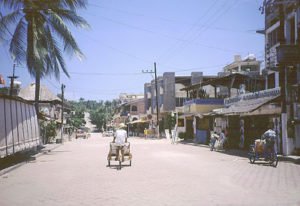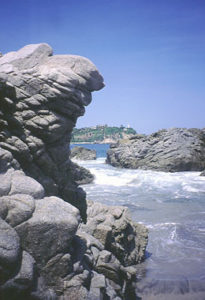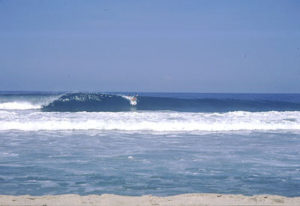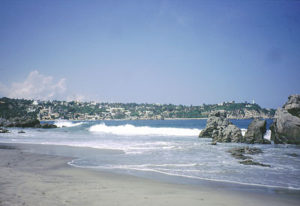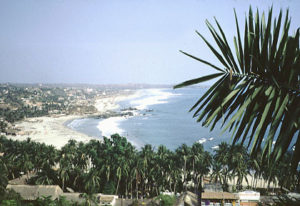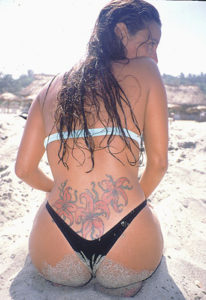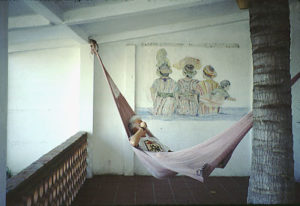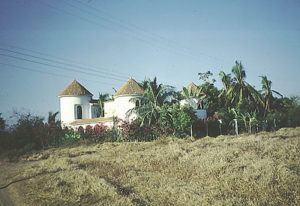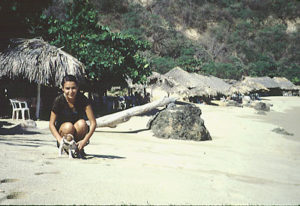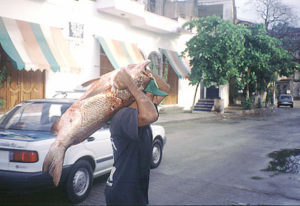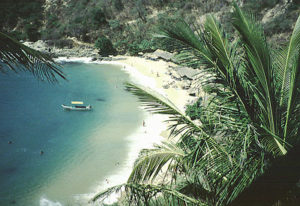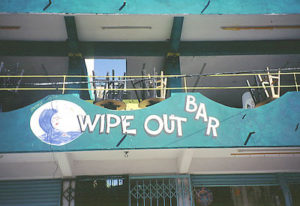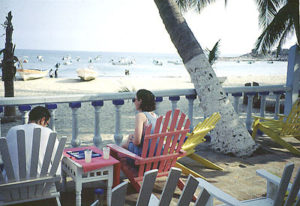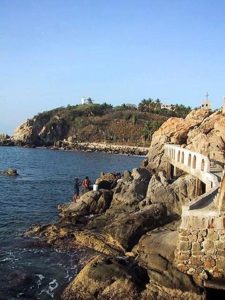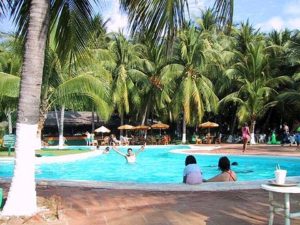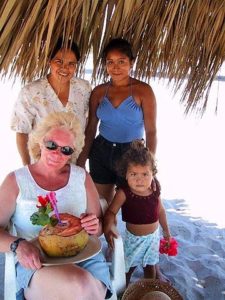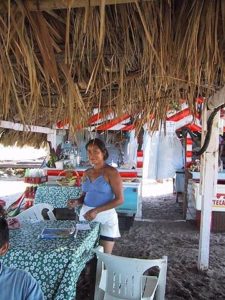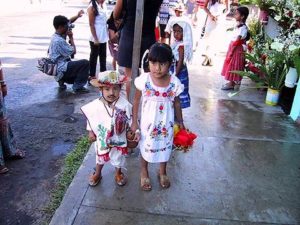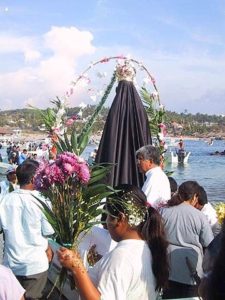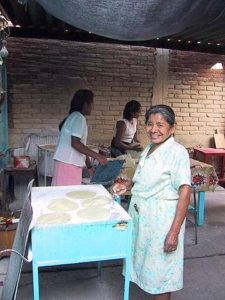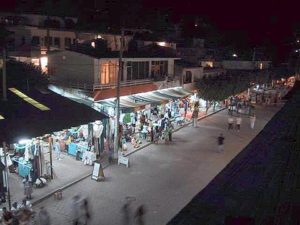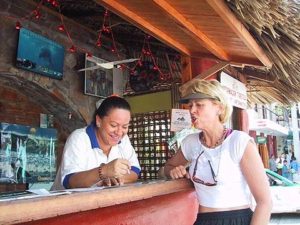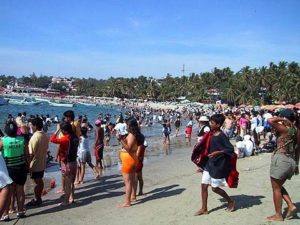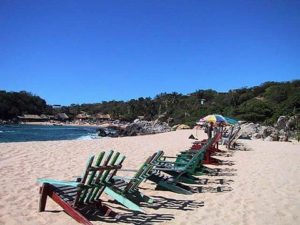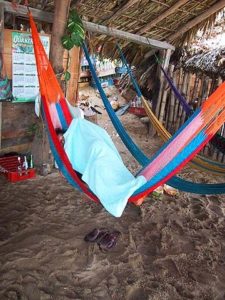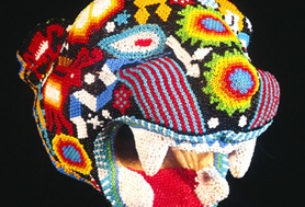In Spanish, Puerto Escondido means ‘hidden port’, and the little beach town tucked away in the southern part of Oaxaca certainly lives up to that name. Part of its elusiveness is because there are no direct jets from Miami, New York, Denver or L.A. This discourages some travelers and tones down the ritz and glitz characteristic of most Mexican beach resorts. Secondly, Puerto Escondido has a well-earned reputation as the “wild west” of Mexican Beaches.
Having lived in the northwest part of Colorado for 10 years, I feel at home in an atmosphere where everything is not concerned withspit and polish. So, I call Puerto Escondido “my” beach. To go to my beach from where I live in Oaxaca, I take a first class bus. Seven hours of hairpin turns later, I’m munching on catch-of-the day and sipping a cerveza fria in the hidden port.
Don’t be fooled, though, by Puerto Escondido’s funky, rustic style. You’ll find lively night clubs where you can don your best t-shirt and white shorts and show off your bronzed bod. There are fine restaurants, plenty of nice, clean accommodations, and a few upscale hotels. They just aren’t as expensive as the mega-resorts, and, heck, you can probably get a room here without reservations — even in peak seasons.
Last January, I was chatting with Sr. Guillermo Sepeda, owner of the Posada Real. I said to him, “I bet this place is on the verge of exploding into an “in” spot.” His shoulders sagged and he answered, “That’s what they’ve been saying for the past ten years.” Although I understood his dismay about the lack of boomtown business, I felt secretly happy that “my” beach town isn’t an “in” place.
Even if it were on the verge of taking off, a few happenings in 1997 and 1998 slowed things down a bit. In October, hurricanes Pauline and Rick wrecked beachfront businesses and played havoc with roads right at a time when people in El Norte were planning their winter getaways. Yet, in typical Mexican style, the beach mess was cleaned up pronto and business back to normal within weeks. But many tourists don’t know that.
Then in March ’98, on Playa Zicatela, a former art college instructor was brutally beaten, raped, and thrown into the ocean where she drowned. Still reeling from bad press from big storms, Puerto Escondido was again in the headlines. Vacationers have known for years it’s not safe to walk along Zicatela beach after dark. The scary part of this incident, in addition to its raw brutality: it happened in the early afternoon. The attack made headlines in the the U.S.
In spite of this, I feel safe in Puerto Escondido. Every day, hundreds of visitors walk the streets and beaches safely, taking normal precautions. So, last April I returned once again to the hidden port. Along the Playa Principal were newly-installed lights. Three armed policemen patrolled Play Zicatela during the day. Lampposts lay along the street paralleling the beach, ready to be hooked up. Perhaps all this was the result of the recent tragedy?
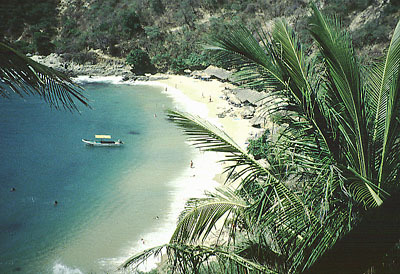
In Puerto Escondido, you’ll find many different beaches, each with its own distinct personality. I invite you to walk with me, beginning on the eastern end and heading west. (Note: even though the Pacific Coast generally runs north and south, the town and beaches of Puerto Escondido actually lie east and west).
We begin at Playa Zicatela, which some call the best surfing beach in North America. Its world-famous surf also causes strong undertow, making it unsafe for swimming, unless you’re an exceptionally strong swimmer.
The wide strip of sand stretches for a mile or more, and is still a surfer’s beach. However, the surrounding area is changing. Where surfers used to live in battered vans and old motor homes, the town has cleared the prickly beach weeds and constructed a promenade of paving stones, beautifully landscaped with flowers and shrubs. Ironically, this may cause a false sense of security among tourists.
Across the street are shoulder-to-shoulder outdoor eateries (many of them new). Hotels along this strip range from the posh Santa Fe which anchors the northern edge and isn’t really on Zicatela, to modest bungalows and cabanas.
Walking along Playa Zicatela toward town, we come to an outcropping of rocks which separates this beach from Playa Marinero–the best in-town swimming spot. The surf and undertow here are less strong. I recommend the Hotel Flor de Maria, on a side street from Playa Marinero. Built and owned by an Italian couple, it’s impeccably maintained, with good food, and a great view of the sunset from the rooftop bar. Across the street, Carmen’s serves the best breakfast I’ve eaten anywhere, but we can’t stop now. We’re on our tour–still heading west.
Next, we come to Playa Principal, the main beach There’s no wall or sign or rope separating it from Playa Marinero. We know we’re on the main beach because of the fishing and pleasure boats and water taxis anchored close to shore (there’s talk of building a wharf). Playa Principal is a great place to people-watch. Beginning at dawn, fishermen come ashore to sell their catch of the day. Restaurateurs and families crowd around the boats vying for the biggest fish with brightest eyes.
During the early evening Happy Hour, beachfront restaurants offer $1 margaritas and other drinks at rock bottom prices. It’s people-meeting time, especially in the bars and restaurants of Hotel Rincon del Pacifico and Las Palmas. If you want to stay here in the heart of the action, double rooms are under 200 pesos.
The main business street, the Perez Gasga (or the Adoquin as the locals call it) parallels the beach and is closed to vehicular traffic in the afternoons and evenings. In this busy shopping district, you can buy everything from silk lounging slacks and teeny bikinis, to wooden beads and native hammocks. Aging hippies, long-haired and tattooed, gather on the sidewalks to beat drums, pick guitars, and play mournful tunes on hand-carved flutes.
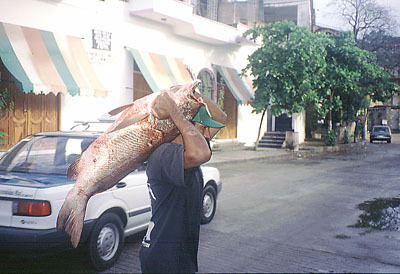
Continuing our tour west, we look toward the lighthouse and see an oceanfront stone walkway. This was damaged by the hurricanes, but is still maneuverable, if we’re careful. On our way, we pass the two open-air dance floors of Tequila Sunrise, a popular nightclub, It’s located just off the Adoquin. You don’t have to trek over this bumpy promenade to get there!
At the end of this walkway, we turn turn right and then left down a road to the beach. (Or, we could have taken a water taxi or street cab to Puerto Angelito). There are actually twin beaches here, separated by an easy-to-cross outcropping of rock. Family-run palapas (open-air eateries with thatched roofs) serve soft drinks, cerveza fria, hamburguesas and fish. But, who would eat anything but fish in Puerto Angelito? Depending on the time of year, you’ll find lobster tails, octopus, shark, red snapper– all grilled outdoors right under your nose! You’ll enjoy safe swimming in this sheltered cove (although water taxis do pull in close to shore). Farther west, (less than a mile, but we can’t walk there because of steep rocky cliffs along the coast) we come to my favorite beach–Playa Carizalillo.
We tell the cab driver to take us to Playa Carizalillo and he drops us off at the campground. From here, we walk down a very steep hill over treacherous loose sand and gravel, but the hike is worth it. This small, lesser-known cove isn’t usually crowded (except on weekends and holidays). The bright turquoise water is crystal clear and gentle waves lap about us as we lazily float and swim–until smells of grilled fish from the palapas call us ashore.
From kids on the beach, we buy peanut-brittle type candy, too sweetly delicious to pass up!
The last, westernmost beach, is Playa Bacocho. We’ll access this through Hotel Posada Real and follow signs to Coco’s Beach Club. This is a great place to hang out for a day (or you might choose to stay in the Posada Real). It’s easy to while away an afternoon, swimming in the huge beachfront pool, eating in the open-air restaurant, and sunning on lounge chairs.
I understand that this beach club and one other are the only development for the next 60 miles. You can walk to the end of the beach (about a mile), climb over rocks and up the hill, and as far as you can see there is nothing but turquoise water and sandy beach. (Note: I wouldn’t advise walking this lonely stretch – from Posada Real northwest – alone. I did it with a group in early morning. Robberies are common along here, they say. After all, this is the “wild west” of Mexican beaches.)
And…I wouldn’t want it any other way.
TO GET THERE
Mexicana has daily flights from Mexico City. Aeromexico and some smaller airlines operate shuttle services from Oaxaca City. There are several first class bus lines that link Oaxaca City and Puerto Escondido.
RESOURCES
First, look up Gina at the tourist booth, west end of the Adoquin. She knows “everything,” and has a smile for everyone. Ask her where you can get the Puerto Escondido Sun, the English newspaper published by Garrick Clayton. This is a must for visitors. Wife Pamela operates the Instituto Bilinque y Cultural and employs Mexicans to teach Spanish. What better place to learn the language!

